 Facebook
Facebook
 X
X
 Instagram
Instagram
 TikTok
TikTok
 Youtube
Youtube

This place is familiar. I used to come here back when it was the Original Sab E Lee, the locally beloved Thai restaurant that moved to a larger space across the street years ago. There wasn’t much to the property back then, and there’s not much to look at as far as the storefront is concerned. Mostly a sign that reads Sushi Yorimichi. But it feels pretty perfect inside.
At least, it does to a guy who spent his teens going to hole-in-the-wall restaurants like this, as a military brat living in Japan. Most obvious are the shoji screens, paper lanterns, and no-frills dining furniture. The sushi bar that’s more of an arched window with, wrapped pieces of fish visible inside a glass cooler case. The case has been plastered with stickers of street racers, exactly the sort of cars my high school friends used to covet. Extra cred achieved if the car possessed Toyota’s near-mythical Hachi-Roku engine.
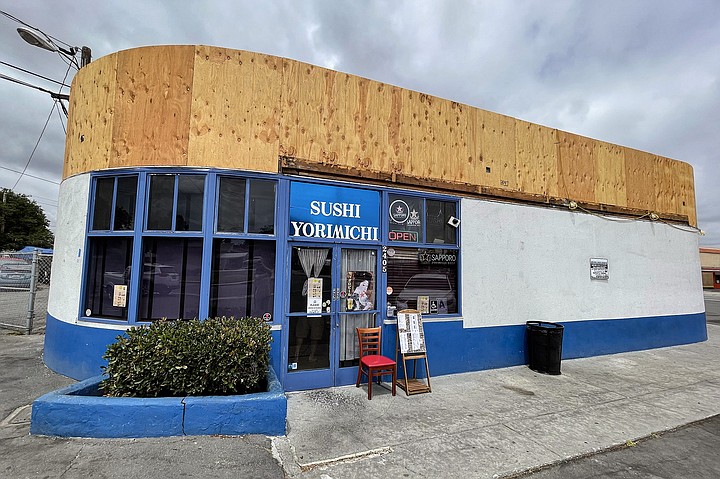
Before I even picked up a menu, the place feels uncannily authentic, right down to the realistic plastic models of sushi nigiri, which sit on display beside a bonsai tree.
The menu smacks authentic, too, though I’ll soon realize there are a few interesting deviations. Not only sushi, but Japanese menu items across the board: yakitori skewers, ramen, chicken karaage, monkfish liver, tempura udon, and katsudon, a breaded pork cutlet served with egg over rice: the go-to order for high school me.
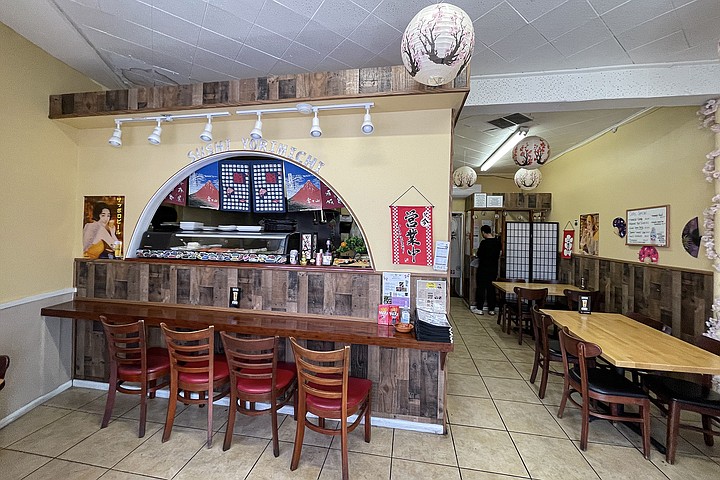
My tastes have broadened since then, and I’ll soon be ordering entirely too much food. This menu might feel at home in an izakaya, the sort of bar and restaurant Japanese folk typically patronize after work. The beer and sake options reenforce the idea, and maybe so does the name. The word yorimichi technically translates to detour, but as they explain to me at the restaurant, it’s colloquially used to describe a sort of spontaneous hangout over food and drinks. My kind of detour.

Fusion is most evident on the noodles menu. This includes classical ramen choices featuring tonkostu (pork bone) or shoyu (soy) based broth. Bu there’s a latent Mexican-styled favorite — birria ramen ($11.25) — and an udon adaptation of Italy’s famed ham and egg pasta, carbonara ($11.50).
Intriguing though these were, we steered away from noodle altogether, choosing to focus instead on meat, seafood, and (as it turned out) eggs.
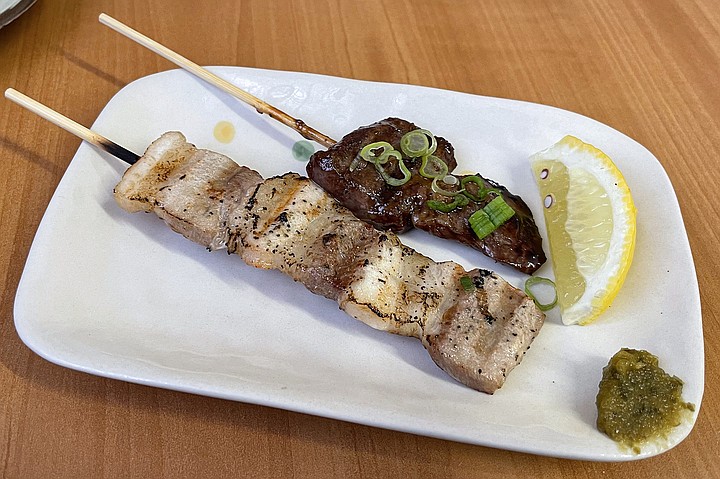
Got started with yakitori meat skewers, keeping it simple with pork belly ($2.75) and skirt steak ($3.50). If this were strictly a yakitori restaurant, I’d still recommend it. With options including ribeye, chicken liver, bacon wrapped okra, scallops, and duck, there’s plenty to snack on all day. As an appetizer, the smart thing to do is pick any four skewers for $14.50.
Next came a spider hand roll (fried softshell crab), and a yellowtail sashimi dish dressed with serrano chilis, spicy ponzu sauce, and a sprinkling of black pepper. I don’t understand how I’ve gone decades without trying black pepper on my sashimi, but I would do so again within a week.
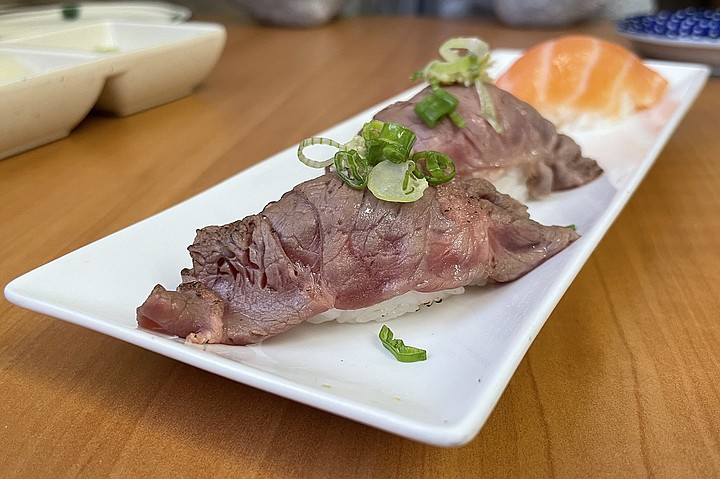
I ordered a few nigiri ($2-5 each), the most interesting involving a thin slice of blowtorched beef laid over the pat of rice ($7 for two). The unseasoned beef benefits more than most fish from a dip in soy sauce.
What I could not resist was ordering from the donburi menu, here made easy to understand as the “sushi bowl” menu. I can’t eat shrimp, so I avoided the house chirashi bowl (422), but the guy at the next table ordered one, and it looked so impressive he let me take a picture. The rice bowl is topped with several pieces of sashimi, plus scallops, sea urchin, salmon roe, and sweet shrimp, including an entire shrimp head, buggy eyes, swimmerets, and all.
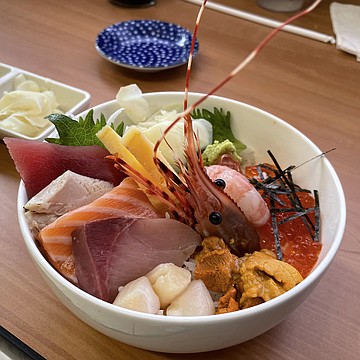
But I could and did order the compelling salmon and uni bowl, which in addition to seared salmon and sea urchin, featured a poached egg, salmon roe, and tobiko flying fish roe. If you’re fond of referring to the edible part of sea urchin as roe, you might call it eggs four ways. This too spares the seasoning, preferring to let all the seafood and chicken yolk do the work.
Some of these will be acquired tastes, and some of the fish won’t live up to that of your favorite sushi spots. However, there’s a sense of affordable indulgence that goes along with that, and a hominess I wouldn’t trade for anything.


This place is familiar. I used to come here back when it was the Original Sab E Lee, the locally beloved Thai restaurant that moved to a larger space across the street years ago. There wasn’t much to the property back then, and there’s not much to look at as far as the storefront is concerned. Mostly a sign that reads Sushi Yorimichi. But it feels pretty perfect inside.
At least, it does to a guy who spent his teens going to hole-in-the-wall restaurants like this, as a military brat living in Japan. Most obvious are the shoji screens, paper lanterns, and no-frills dining furniture. The sushi bar that’s more of an arched window with, wrapped pieces of fish visible inside a glass cooler case. The case has been plastered with stickers of street racers, exactly the sort of cars my high school friends used to covet. Extra cred achieved if the car possessed Toyota’s near-mythical Hachi-Roku engine.

Before I even picked up a menu, the place feels uncannily authentic, right down to the realistic plastic models of sushi nigiri, which sit on display beside a bonsai tree.
The menu smacks authentic, too, though I’ll soon realize there are a few interesting deviations. Not only sushi, but Japanese menu items across the board: yakitori skewers, ramen, chicken karaage, monkfish liver, tempura udon, and katsudon, a breaded pork cutlet served with egg over rice: the go-to order for high school me.

My tastes have broadened since then, and I’ll soon be ordering entirely too much food. This menu might feel at home in an izakaya, the sort of bar and restaurant Japanese folk typically patronize after work. The beer and sake options reenforce the idea, and maybe so does the name. The word yorimichi technically translates to detour, but as they explain to me at the restaurant, it’s colloquially used to describe a sort of spontaneous hangout over food and drinks. My kind of detour.

Fusion is most evident on the noodles menu. This includes classical ramen choices featuring tonkostu (pork bone) or shoyu (soy) based broth. Bu there’s a latent Mexican-styled favorite — birria ramen ($11.25) — and an udon adaptation of Italy’s famed ham and egg pasta, carbonara ($11.50).
Intriguing though these were, we steered away from noodle altogether, choosing to focus instead on meat, seafood, and (as it turned out) eggs.

Got started with yakitori meat skewers, keeping it simple with pork belly ($2.75) and skirt steak ($3.50). If this were strictly a yakitori restaurant, I’d still recommend it. With options including ribeye, chicken liver, bacon wrapped okra, scallops, and duck, there’s plenty to snack on all day. As an appetizer, the smart thing to do is pick any four skewers for $14.50.
Next came a spider hand roll (fried softshell crab), and a yellowtail sashimi dish dressed with serrano chilis, spicy ponzu sauce, and a sprinkling of black pepper. I don’t understand how I’ve gone decades without trying black pepper on my sashimi, but I would do so again within a week.

I ordered a few nigiri ($2-5 each), the most interesting involving a thin slice of blowtorched beef laid over the pat of rice ($7 for two). The unseasoned beef benefits more than most fish from a dip in soy sauce.
What I could not resist was ordering from the donburi menu, here made easy to understand as the “sushi bowl” menu. I can’t eat shrimp, so I avoided the house chirashi bowl (422), but the guy at the next table ordered one, and it looked so impressive he let me take a picture. The rice bowl is topped with several pieces of sashimi, plus scallops, sea urchin, salmon roe, and sweet shrimp, including an entire shrimp head, buggy eyes, swimmerets, and all.

But I could and did order the compelling salmon and uni bowl, which in addition to seared salmon and sea urchin, featured a poached egg, salmon roe, and tobiko flying fish roe. If you’re fond of referring to the edible part of sea urchin as roe, you might call it eggs four ways. This too spares the seasoning, preferring to let all the seafood and chicken yolk do the work.
Some of these will be acquired tastes, and some of the fish won’t live up to that of your favorite sushi spots. However, there’s a sense of affordable indulgence that goes along with that, and a hominess I wouldn’t trade for anything.
Comments